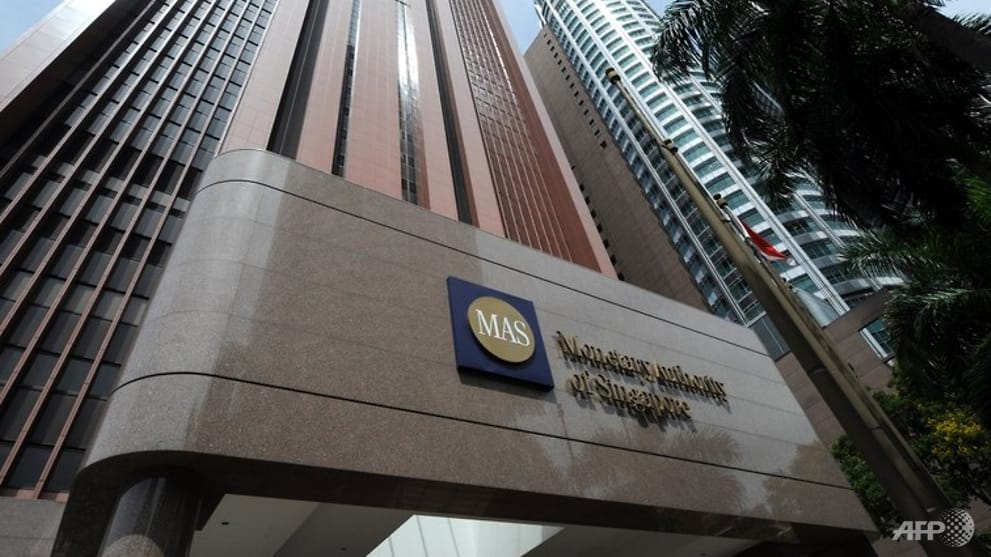
SINGAPORE: The Monetary Authority of Singapore (MAS) on Wednesday (Oct 14) kept its exchange rate-based monetary policy unchanged after two consecutive rounds of easing, in line with market expectations.
In its half-yearly monetary policy statement, the Singapore central bank said it will “maintain a zero per cent per annum rate of appreciation of the policy band”.
There are no changes to the width of the policy band and the level at which it is centred.
All 14 economists polled by Reuters had predicted that the central bank would stand pat on its monetary settings.
The MAS said the Singapore economy is expected to see a recovery next year, alongside receding disinflation risk. But underlying growth momentum will be "weak" and the "negative output gap will only narrow slowly in the year ahead".
READ: Singapore's third-quarter GDP shrinks at slower pace of 7% after economy gradually reopens following circuit breaker
It added that even though core inflation - a key policy consideration for the central bank - will rise gradually and turn positive in 2021, it is set to remain well below its long-term average.
“As core inflation is expected to stay low, MAS assesses that an accommodative policy stance will remain appropriate for some time,” it said in its policy statement.
“This will complement fiscal policy efforts to mitigate the economic impact of COVID-19 and ensure price stability over the medium term.”
Unlike most central banks that manage monetary policy through the interest rate, the MAS uses the exchange rate as its main policy tool.
This refers to the Singapore dollar nominal effective exchange rate (S$NEER) – the exchange rate of the Singapore dollar managed against a trade-weighted basket of currencies from Singapore’s major trading partners.
The S$NEER is allowed to float within an unspecified band. Should it go out of this band, the MAS steps in by buying or selling Singapore dollars.
READ: The S$NEER and its slope, width and centre: Questions about Singapore’s monetary policy
The central bank also changes the slope, width and mid-point of this band when it wants to adjust the pace of appreciation or depreciation of the local currency based on assessed risks to Singapore’s growth and inflation.
The MAS reduced the pace of the Singapore dollar’s appreciation “slightly” in October last year, as growth slowed on the back of trade tensions.
In March, it followed up with another easing move by further reducing the slope of its currency band to zero and re-centering the band downwards.
It said then that fiscal policy played the “primary role” of mitigating the economic impact of COVID-19.
So far, the Singapore Government has pumped in nearly S$100 billion worth of stimulus and emergency relief measures to blunt the impact of the pandemic.
ECONOMIC OUTLOOK
Separate preliminary data released on Wednesday morning showed the economy shrank at a slower pace of 7 per cent year-on-year in the third quarter, compared with the 13.3 per cent plunge in the second quarter.
The improved performance in the third quarter came as Singapore gradually reopened its economy following the COVID-19 "circuit breaker" that was implemented between Apr 7 and Jun 1, said the Ministry of Trade and Industry.
READ: Singapore narrows 2020 GDP forecast range as economy sees record quarterly slump in Q2
Beyond this “immediate rebound”, MAS said Singapore's economic growth momentum is likely to be “modest” given a sluggish external backdrop, persistent weakness in some domestic services sectors and limited recovery in the travel-related industry.
The Singapore economy is forecast to shrink between 5 per cent and 7 per cent this year. It is poised to see “above-trend growth” for 2021, due to this year's low-base effect.
“Barring a renewed worsening of the course of the COVID-19 pandemic, the Singapore economy is expected to expand in 2021, following the recession this year,” added the central bank.
The MAS also upgraded its forecasts for inflation this year, noting that both core and headline inflation are set to come in between -0.5 and 0 per cent. It previously estimated both indicators to average between -1 and 0 per cent.
For next year, it sees core inflation at 0 to 1 per cent, while headline inflation is projected to be between −0.5 and 0.5 per cent.
Mr Alex Holmes, an economist from research firm Capital Economics, said the decision by the MAS to keep its policy on hold “came as no surprise”.
With the output gap – defined as the difference between the actual output of an economy and its potential output – set to remain large for some time, monetary policy is likely to stay supportive.
“We expect policy settings to remain unchanged for at least the next year,” added Mr Holmes in a note.
Article From & Read More ( MAS stands pat on monetary policy, says accommodative stance remains appropriate 'for some time' - CNA )https://ift.tt/3jVm1Oo
Business
No comments:
Post a Comment